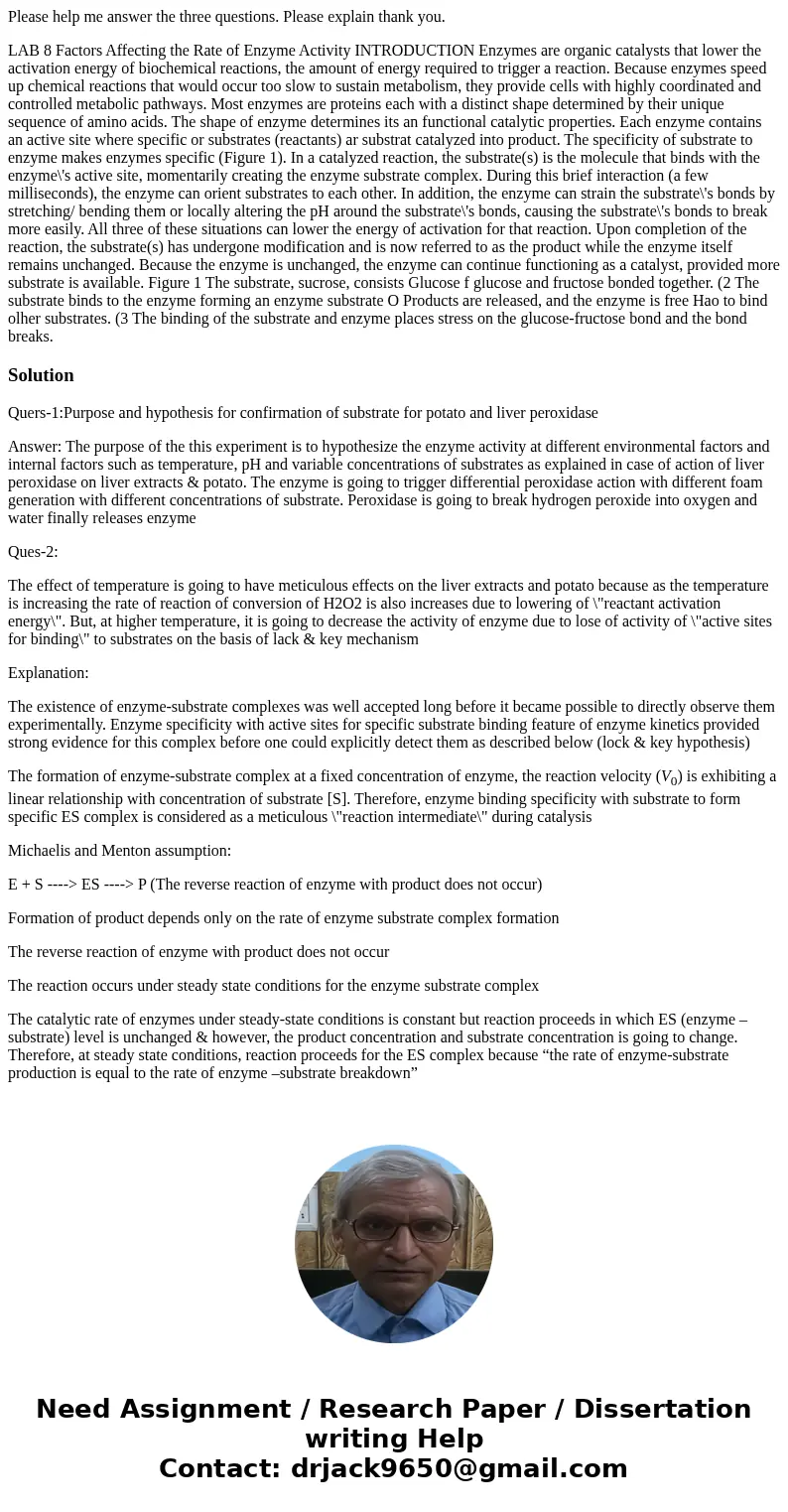Please help me answer the three questions Please explain tha
Please help me answer the three questions. Please explain thank you.
LAB 8 Factors Affecting the Rate of Enzyme Activity INTRODUCTION Enzymes are organic catalysts that lower the activation energy of biochemical reactions, the amount of energy required to trigger a reaction. Because enzymes speed up chemical reactions that would occur too slow to sustain metabolism, they provide cells with highly coordinated and controlled metabolic pathways. Most enzymes are proteins each with a distinct shape determined by their unique sequence of amino acids. The shape of enzyme determines its an functional catalytic properties. Each enzyme contains an active site where specific or substrates (reactants) ar substrat catalyzed into product. The specificity of substrate to enzyme makes enzymes specific (Figure 1). In a catalyzed reaction, the substrate(s) is the molecule that binds with the enzyme\'s active site, momentarily creating the enzyme substrate complex. During this brief interaction (a few milliseconds), the enzyme can orient substrates to each other. In addition, the enzyme can strain the substrate\'s bonds by stretching/ bending them or locally altering the pH around the substrate\'s bonds, causing the substrate\'s bonds to break more easily. All three of these situations can lower the energy of activation for that reaction. Upon completion of the reaction, the substrate(s) has undergone modification and is now referred to as the product while the enzyme itself remains unchanged. Because the enzyme is unchanged, the enzyme can continue functioning as a catalyst, provided more substrate is available. Figure 1 The substrate, sucrose, consists Glucose f glucose and fructose bonded together. (2 The substrate binds to the enzyme forming an enzyme substrate O Products are released, and the enzyme is free Hao to bind olher substrates. (3 The binding of the substrate and enzyme places stress on the glucose-fructose bond and the bond breaks.Solution
Quers-1:Purpose and hypothesis for confirmation of substrate for potato and liver peroxidase
Answer: The purpose of the this experiment is to hypothesize the enzyme activity at different environmental factors and internal factors such as temperature, pH and variable concentrations of substrates as explained in case of action of liver peroxidase on liver extracts & potato. The enzyme is going to trigger differential peroxidase action with different foam generation with different concentrations of substrate. Peroxidase is going to break hydrogen peroxide into oxygen and water finally releases enzyme
Ques-2:
The effect of temperature is going to have meticulous effects on the liver extracts and potato because as the temperature is increasing the rate of reaction of conversion of H2O2 is also increases due to lowering of \"reactant activation energy\". But, at higher temperature, it is going to decrease the activity of enzyme due to lose of activity of \"active sites for binding\" to substrates on the basis of lack & key mechanism
Explanation:
The existence of enzyme-substrate complexes was well accepted long before it became possible to directly observe them experimentally. Enzyme specificity with active sites for specific substrate binding feature of enzyme kinetics provided strong evidence for this complex before one could explicitly detect them as described below (lock & key hypothesis)
The formation of enzyme-substrate complex at a fixed concentration of enzyme, the reaction velocity (V0) is exhibiting a linear relationship with concentration of substrate [S]. Therefore, enzyme binding specificity with substrate to form specific ES complex is considered as a meticulous \"reaction intermediate\" during catalysis
Michaelis and Menton assumption:
E + S ----> ES ----> P (The reverse reaction of enzyme with product does not occur)
Formation of product depends only on the rate of enzyme substrate complex formation
The reverse reaction of enzyme with product does not occur
The reaction occurs under steady state conditions for the enzyme substrate complex
The catalytic rate of enzymes under steady-state conditions is constant but reaction proceeds in which ES (enzyme –substrate) level is unchanged & however, the product concentration and substrate concentration is going to change. Therefore, at steady state conditions, reaction proceeds for the ES complex because “the rate of enzyme-substrate production is equal to the rate of enzyme –substrate breakdown”

 Homework Sourse
Homework Sourse